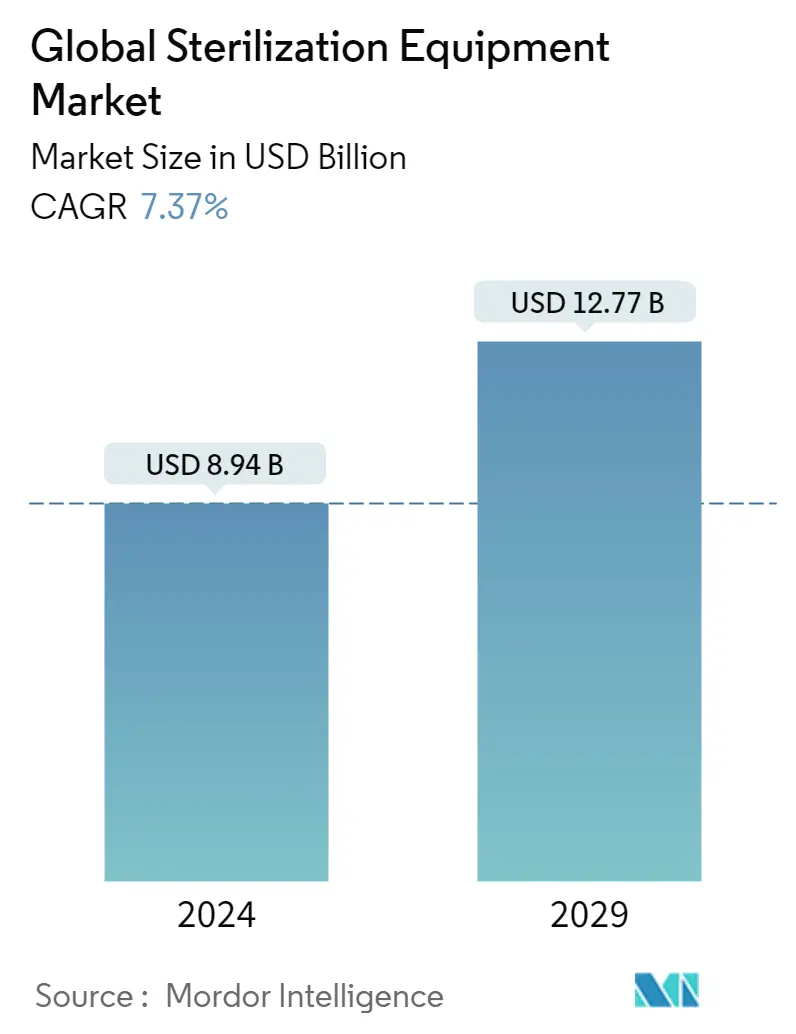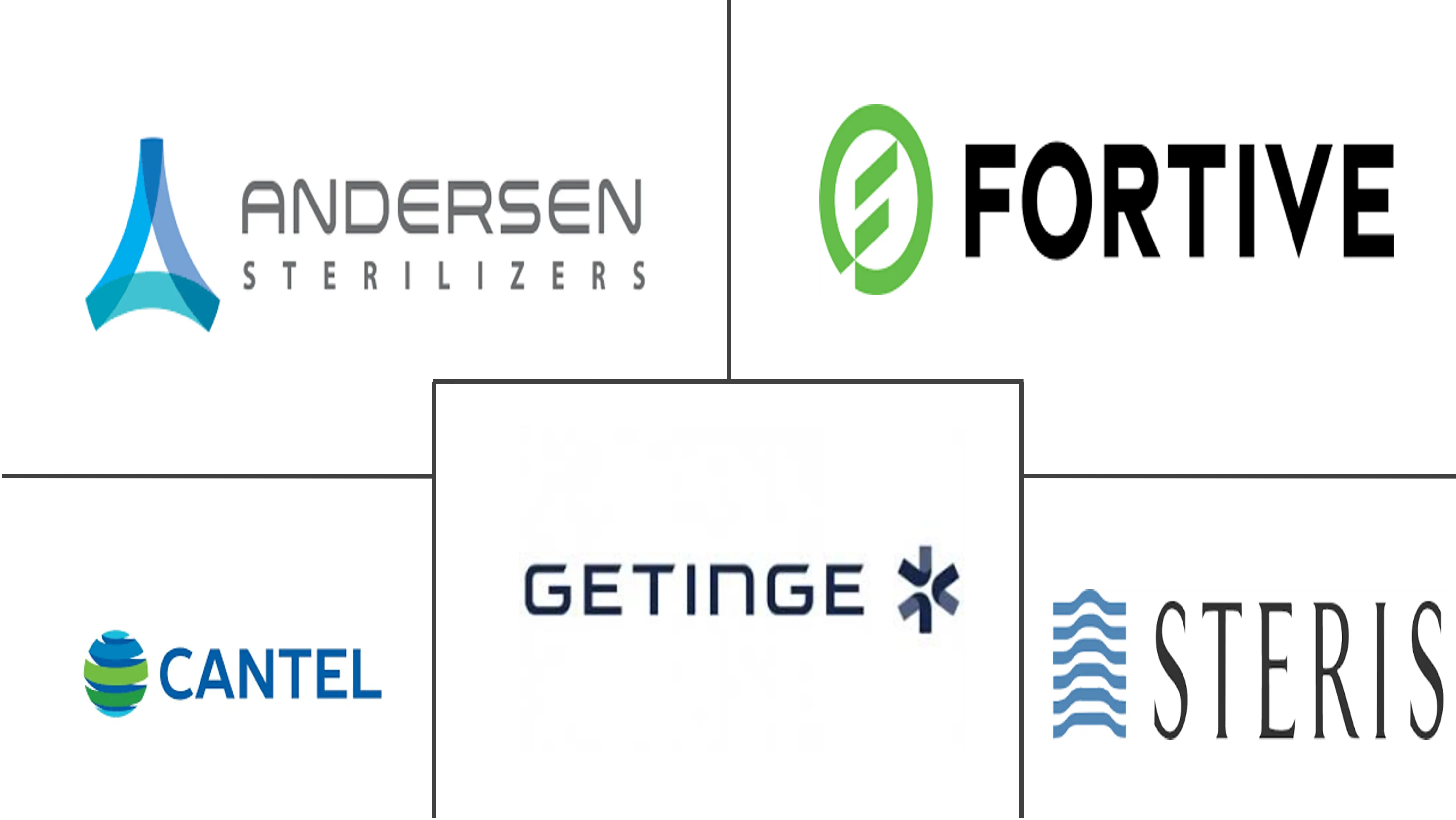Market Size of Global Sterilization Equipment Industry

| Study Period | 2019 - 2029 |
| Market Size (2024) | USD 8.94 Billion |
| Market Size (2029) | USD 12.77 Billion |
| CAGR (2024 - 2029) | 7.37 % |
| Fastest Growing Market | Asia Pacific |
| Largest Market | North America |
Major Players
*Disclaimer: Major Players sorted in no particular order |
Sterilization Equipment Market Analysis
The Global Sterilization Equipment Market size is estimated at USD 8.94 billion in 2024, and is expected to reach USD 12.77 billion by 2029, growing at a CAGR of 7.37% during the forecast period (2024-2029).
The COVID-19 pandemic has altered healthcare priorities, adversely impacting healthcare management. In the initial days of the pandemic, several countries were in lockdown. They suspended trade with other countries and implemented travel restrictions, leading to a decline in healthcare services such as treatments, diagnosis, and surgical procedures in the first half of 2020. Preventing hospital-acquired infections is a critical aspect of the clinical management of COVID-19, as hospital-acquired infections have been a common feature of such outbreaks. According to the study titled 'Hospital-acquired SARS-CoV-2 infection in the UK's first COVID-19 pandemic wave', published in August 2021, 11.3% of patients with COVID-19 in 314 UK hospitals became infected after hospital admission. This rate increased to 15.8% in May 2020. Thus, the outbreak has impacted the healthcare facilities' ability to manage hospital-acquired infections, significantly increasing the demand for sterilizers. Due to the rising COVID-19 cases, government associations also worked toward reducing the COVID-19 impact. For instance, as per a March 2020 update by the US Food and Drug Administration (USFDA), Guidance for Industry and Food and Drug Administration Staff, it is adequate to maintain the supply of sterilizers, disinfectant devices, and air purifiers that can facilitate the rapid turnaround of sterilized or disinfected medical equipment and help reduce the risk of viral exposure for patients and healthcare providers to SARS-CoV-2 for public health emergency during the COVID-19 pandemic. The USFDA believes that the policy outlined will help address these urgent public health concerns by increasing the availability of sterilizers, disinfectant devices, and air purifiers during this public health emergency.
With the growing global population, the prevalence of various infectious diseases has rapidly increased. Many of these diseases require medical interventions and surgeries. The instruments and devices used in the surgeries need to be sterilized. Moreover, the infected instruments may give rise to the cross-transmission of diseases. According to the National Plastic Surgery Statistics 2020 by the American Society of Plastic Surgeons, 2,314720 cosmetic surgical procedures were performed in the United States in 2020, and 2,678,302 surgeries were performed in 2019. Additionally, the total number of reconstructive procedures performed in 2020 and 2019 were 6,878,486 and 6,652,591, respectively, in the United States. As these surgeries require sterilized instruments, the market is expected to witness significant growth in the coming years.
These factors have given rise to the need for sterilization equipment to prevent the further spread of infectious diseases. The expansion of pharmaceutical companies has also been a major factor in the market's growth. However, stringent regulatory standards for approval, production of these devices, and disadvantages of chemical agents used as chemical sterilants in some equipment, which may cause potential damage to the eyes and skin, have been restraining the market's growth.
Sterilization Equipment Industry Segmentation
Sterilization equipment is used to eliminate and disinfect life forms, such as bacteria, fungi, viruses, and other biological agents. As per the scope of the report, sterilization equipment is an essential step in the reprocessing of reusable medical instruments and surgical instruments that have been contaminated, or potentially contaminated, by the patient's biological fluids. The aim of the sterilization is the prevention of potential cross-infection between patients by killing micro-organisms, such as bacteria, viruses, and many others. Therefore, effective cleaning of the instrument is particularly important to remove contamination physically. The Market is Segmented by Equipment (High-temperature Sterilization, Low-temperature Sterilization, Filtration Sterilization, and Ionizing Radiation Sterilization), End User (Hospitals and Clinics, Pharmaceutical and Biotechnology Companies, Education and Research Institutes, Food and Beverage Industries, Other End Users), and Geography North America, Europe, Asia-Pacific, Middle East and Africa, and South America). The market report also covers the estimated market sizes and trends for 17 different countries across major regions, globally. The report offers the value (in USD million) for the above segments.
| By Equipment | ||||||
| ||||||
| ||||||
| Filtration Sterilization | ||||||
|
| By End User | |
| Hospitals and Clinics | |
| Pharmaceutical and Biotechnology Companies | |
| Education and Research Institutes | |
| Food and Beverage Industries | |
| Other End Users |
| By Geography | ||||||||
| ||||||||
| ||||||||
| ||||||||
| ||||||||
|
Global Sterilization Equipment Market Size Summary
The sterilization equipment market is poised for significant growth, driven by the increasing need to prevent hospital-acquired infections and the rising prevalence of infectious diseases globally. The COVID-19 pandemic has underscored the critical importance of sterilization in healthcare settings, as it highlighted the risks of cross-contamination and the spread of infections within hospitals. This has led to a heightened demand for sterilization equipment, particularly in regions like North America, where the incidence of hospital-acquired infections remains a concern. The market is characterized by the dominance of high-temperature sterilization equipment, which is favored for its effectiveness and cost-efficiency. Technological advancements and the introduction of new products further bolster the market's expansion, as seen with innovations like the Esco CelCulture CO2 Incubator and Midmark's updated sterilizers.
The market's growth is also supported by the increasing number of surgical procedures and the expansion of pharmaceutical companies, which necessitate the use of sterilized instruments to ensure patient safety. Despite the challenges posed by stringent regulatory standards and the potential drawbacks of chemical sterilants, the market continues to thrive, driven by the efforts of major players such as Getinge AB, Fortive Corporation, and STERIS PLC. These companies leverage their research capabilities and distribution networks to maintain a competitive edge. Additionally, the aging population, particularly in regions like the United States, contributes to the market's growth, as older individuals are more susceptible to infections and require more medical interventions. Overall, the sterilization equipment market is expected to experience robust growth, supported by ongoing technological advancements and the increasing demand for effective infection control solutions.
Global Sterilization Equipment Market Size - Table of Contents
-
1. MARKET DYNAMICS
-
1.1 Market Overview
-
1.2 Market Drivers
-
1.2.1 Increasing Risks of Cross-transmission
-
1.2.2 Increasing Number of Surgical Procedures
-
1.2.3 Growth in Pharmaceutical and Biotechnology Industries
-
-
1.3 Market Restraints
-
1.3.1 High Cost Associated with the Device
-
1.3.2 Exposure to Chemicals in Equipments
-
-
1.4 Porter's Five Forces Analysis
-
1.4.1 Threat of New Entrants
-
1.4.2 Bargaining Power of Buyers/Consumers
-
1.4.3 Bargaining Power of Suppliers
-
1.4.4 Threat of Substitute Products
-
1.4.5 Intensity of Competitive Rivalry
-
-
-
2. MARKET SEGMENTATION (Market Size by Value - USD million)
-
2.1 By Equipment
-
2.1.1 High-temperature Sterilization
-
2.1.1.1 Wet/Steam Sterilization
-
2.1.1.2 Dry Sterilization
-
-
2.1.2 Low-temperature Sterilization
-
2.1.2.1 Ethylene Oxide (ETO)
-
2.1.2.2 Hydrogen Peroxide
-
2.1.2.3 Ozone
-
2.1.2.4 Other Low-temperature Sterilization Equipment
-
-
2.1.3 Filtration Sterilization
-
2.1.4 Ionizing Radiation Sterilization
-
2.1.4.1 E-beam Radiation Sterilization
-
2.1.4.2 Gamma Sterilization
-
2.1.4.3 Other Ionizing Radiation Sterilization Equipment
-
-
-
2.2 By End User
-
2.2.1 Hospitals and Clinics
-
2.2.2 Pharmaceutical and Biotechnology Companies
-
2.2.3 Education and Research Institutes
-
2.2.4 Food and Beverage Industries
-
2.2.5 Other End Users
-
-
2.3 By Geography
-
2.3.1 North America
-
2.3.1.1 United States
-
2.3.1.2 Canada
-
2.3.1.3 Mexico
-
-
2.3.2 Europe
-
2.3.2.1 Germany
-
2.3.2.2 United Kingdom
-
2.3.2.3 France
-
2.3.2.4 Italy
-
2.3.2.5 Spain
-
2.3.2.6 Rest of Europe
-
-
2.3.3 Asia-Pacific
-
2.3.3.1 China
-
2.3.3.2 Japan
-
2.3.3.3 India
-
2.3.3.4 Australia
-
2.3.3.5 South Korea
-
2.3.3.6 Rest of Asia-Pacific
-
-
2.3.4 Middle-East and Africa
-
2.3.4.1 GCC
-
2.3.4.2 South Africa
-
2.3.4.3 Rest of Middle-East and Africa
-
-
2.3.5 South America
-
2.3.5.1 Brazil
-
2.3.5.2 Argentina
-
2.3.5.3 Rest of South America
-
-
-
Global Sterilization Equipment Market Size FAQs
How big is the Global Sterilization Equipment Market?
The Global Sterilization Equipment Market size is expected to reach USD 8.94 billion in 2024 and grow at a CAGR of 7.37% to reach USD 12.77 billion by 2029.
What is the current Global Sterilization Equipment Market size?
In 2024, the Global Sterilization Equipment Market size is expected to reach USD 8.94 billion.

